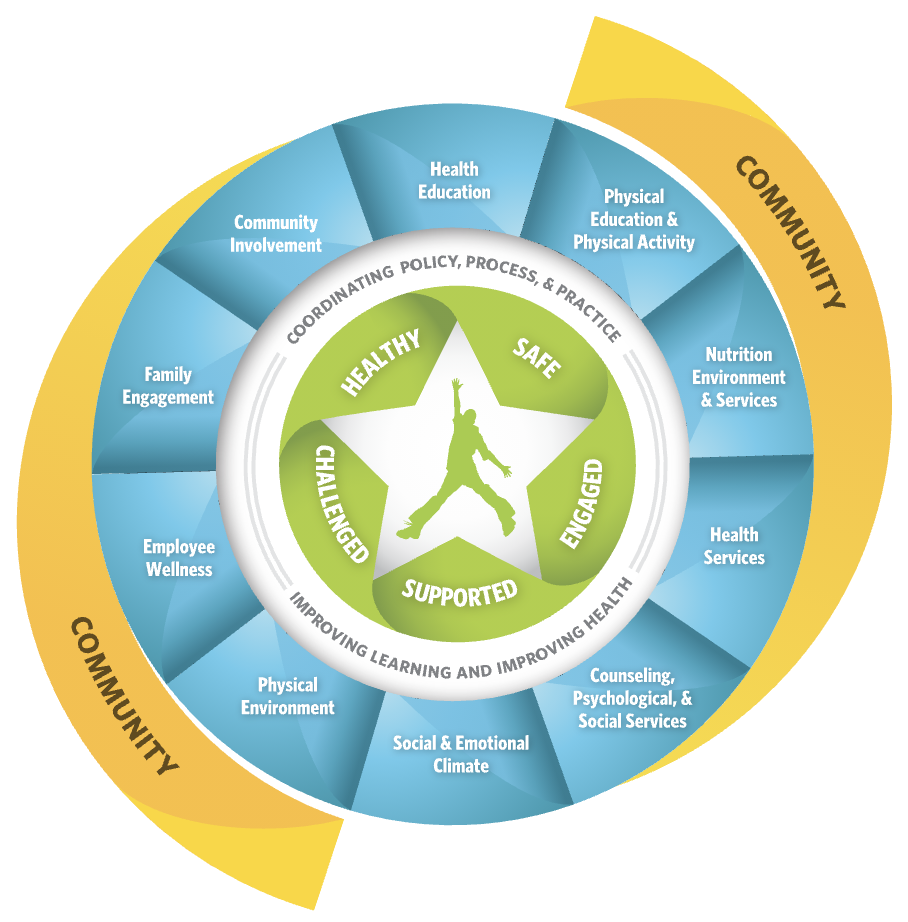Nutrition and Wellness
LACOE Nutrition and Wellness Programs provides technical assistance and professional learning opportunities to improve and expand nutrition education and local school wellness policy efforts using evidence-based information and resources such as the Whole School, Whole Community, and Whole Child (WSCC) model.
Follow this link to access LACOE’s Local School Wellness Policy (LSWP) - BP 5030 (Student Wellness)
The Whole School, Whole Community, Whole Child (WSCC) model is a comprehensive, evidence-based approach to address the physical, mental, and social emotional health of students and their school community. This model provides excellent opportunities for LEAs to make strong connections to the Local Control Accountability Plan and other high priorities such as mental health services and supports, social emotional learning, chronic absenteeism, and access to school nutrition in order to maximize student achievement.
LEAs that adopt a whole child approach can establish collaborative, equitable policies and infrastructure to support implementation using their Local School Wellness Policy (LSWP). The LSWP is an effective and sustainable tool that guides a LEA’s efforts to establish a school environment that promotes students’ health, well-being, and ability to learn. LEAs can use the LSWP to communicate and evaluate health and wellness policies and practices for any of the 10 WSCC Components, which can also strengthen LCAP development and implementation.
Whole School, Whole Community, Whole Child (WSCC) Model


Health Education
When provided by qualified, trained teachers, health education helps students acquire the knowledge, attitudes, and skills they need for making healthy decisions. For general health education, go to LACOE Health Education. For health education on tobacco, go to LACOE Tobacco Use Prevention Education.
Physical Education & Physical Activity
Physical education helps students develop motor skills, knowledge, and behaviors.
Nutrition Environment & Services
School nutrition services provide students with opportunities to learn about and practice healthy eating.
Health Services
School health services provide first aid, emergency care, and assessment of and planning for chronic conditions. In addition, services provide wellness promotion, referral to prevention services (such as HIV testing), and student and parent education. The services also ensure access or referrals to outside health care providers.
Counseling, Psychological, & Social Services
These prevention and intervention services support the mental, behavioral, social, and emotional health of students. Services include a broad range of assessments, counseling and consultation, and referrals to school and community support services.
Social & Emotional Climate
A positive social and emotional school climate is conducive to effective teaching and learning. The school climate can affect student engagement in school activities relationships with other students, staff, family, and community; health and growth; and academic performance.
Physical Environment
A healthy and safe physical school environment promotes learning by ensuring the health and safety of students and staff.
Employee Wellness
Fostering the physical and mental health of school employees protects school staff and, by doing so, helps to support students' health and academic success. Healthy school employees are more productive and less likely to be absent.
Family Engagement
Families and school staff work together to support and improve students' learning, development, and health.
Community Involvement
Community groups and local businesses can create partnerships with schools, share resources, and volunteer to support student learning and health-related activities. Schools, students, and their families can contribute to the community through student learning and by sharing school facilities with community members.

Why focus on nutrition and wellness?
Positive health behaviors impact students and learning. Nutrition and physical activity are two areas that may significantly affect the health and psycho-social determinants of attendance and learning. Research demonstrates that proper nutrition and food security are associated with:
- Increased health: physical, mental, social and emotional
- Decreased chronic illness
- Increased attendance
- Increased attention span/concentration
- Increased cognition and cognitive processing speed
- Increased retention
- Increased academic achievement
- Higher standardized academic test scores
- Decreased anxiety and depression
Schools have the means to provide students with access to nutritious food and physical activity opportunities that can have positive effects upon neurological, metabolic, cardio-respiratory, and skeletal body systems. It is even more important now to ensure that students have access to healthy meals and make time for movement to maintain a high level of concentration and focus that is needed for learning and engagement.
The establishment, implementation, and monitoring of local school wellness policies and regulations may assist school districts in meeting student health needs. LSWP allows the possibility to connect programs such as LCAP, MTSS, and PBIS, and determine how key stakeholders can synergize efforts through coordination to ensure the school environment and practices work to improve health.
Services
LACOE Nutrition and Wellness programs unit offers the following services to support the expansion and implementation of nutrition and wellness-related efforts to promote safe, healthy, and supportive school environments.

- Technical assistance and professional learning opportunities to support the development, expansion, implementation, evaluation, and monitoring of LSWP.
- Support parent and student engagement.
- Encourage use of policies and practices that promote employee wellness.
- Strategies to improve food security and reduce food waste.
- Expand community partnerships.

- Nutrition education trainings and classes for students, parents, teachers, administrators, and other district staff.
- Support the implementation of evidence-based nutrition and physical activity resources.
- Convene school districts to share best practices and successful strategies for implementation.

- Opportunities to integrate LSWP with other educational programs and district priorities such as LCAP, MTSS, SEL, and PBIS to improve student academic achievement, engagement, and attendance.
- Support to wellness leaders and advocates.
- Assistance with LSWP action planning.
- Facilitation of school wellness committee meetings and strengthening existing committee efforts using the WSCC model

Nutrition and Wellness Resources
A collection of evidence-based tools and resources to support nutrition and wellness efforts.

Funding and Partnership Opportunities
Click the button below to access a Google Drive folder that is intended to serve as a hub of resources for LEAs to view current funding and partnership opportunities to support wellness efforts in Los Angeles County. Please check back often as more content will be added.